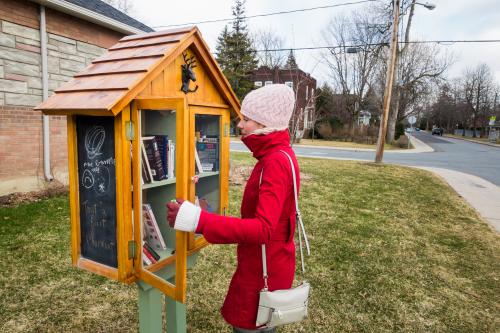
Smart devices can help us stay connected, but if you’ve been at a family gathering where everyone has their nose in a smartphone, you know that they can also contribute to isolation.
Sometimes, old-fashioned analog solutions can be the best way to strengthen relationships and form new ones in your community. Here are a few of our editors’ new favorites.
Celebrate Neighborday
For the past several years, GOOD magazine has designated the last Saturday in April as Neighborday, “a holiday all about getting a little face time with the folks who share your walls and fences.”
How you celebrate is up to you: Leave kind notes in your neighbors’ mailboxes. Bring them some yummy baked goods. Organize a neighborhood clean-up or a book or clothing swap. Or throw a block party and invite them all over for a barbecue or potluck.
Download GOOD’s Neighborday toolkit and register your event.
Set Up a Little Free Library
 Got a bunch of extra books on hand that you probably won’t need again? Consider setting up a Little Free Library, which are popping up in cities and towns across the US.
Got a bunch of extra books on hand that you probably won’t need again? Consider setting up a Little Free Library, which are popping up in cities and towns across the US.
To start one, all you do is buy or construct a box on your property—preferably at eye level. Then, pack the box with your old books and invite your neighbors and visitors to leave a book or take a book. Little Free Libraries have become so common that many people now recognize them on sight, so you shouldn’t have to put a ton of effort into starting the process.
Little Free Libraries are great ways to share resources, and they can provide a catalyst for fun conversations about books with your friends and neighbors.
Get free building and installation plans at LittleFreeLibrary.org. The site also allows you to post your library on its world map, to help others find it.
Plant a Climate Garden for All
Green America’s (Re)Store It! program aims to promote regenerative agriculture, a type of farming that builds healthy soil and turns it into a carbon sink. Now, you can get in on the action and get to know your neighbors by setting up a Climate Victory Garden for your community to share.
Any food garden can be a Climate Victory Garden (see p. 4). Inspired by the Allied Victory Gardens in WWII, these gardens turn the dirt in your backyard into a restorative, climate-cooling patch of healthy soil. All you have to do is use regenerative farming techniques like rotating plants, avoiding chemicals, planting cover crops, and more. Find resources to grow a climate garden.
And get tips on turning your garden into a community garden from the American Community Gardening Association.
Install a “Bucket List” Wall
Started by artist Candy Chang, Before I Die walls are part of a global art project that invites people to contemplate their lives and goals, and share them with others.
Communities, libraries, museums, and other venues in 70 countries have created “Before I Die” walls. The premise is simple: You set up a chalkboard or set out some sticky notes near a wall and ask people to write down a goal or dream they want to accomplish in their lifetime.
“Each wall is created by local residents who want to make a space in their community to restore perspective and share more with one another. Each wall is a tribute to living an examined life,” says the organization.
Chang released a book in 2013 with her favorite “Before I Die” responses, which include “... create a typeface of my own”; “...see where my Grandma grew up”; and “...stop being afraid.”
To view more examples and apply for free resources, visit beforeidie.city.
Share Your Stuff and Skills
The Green American has featured several ways to swap goods and share talents in past issues—like swapping child-, pet-, or elder care; starting a meal co-op; launching a home repair team; or starting a community solar project. Have other ideas? Send them to editors@greenamerica.org, and we’ll print them in a future issue.







